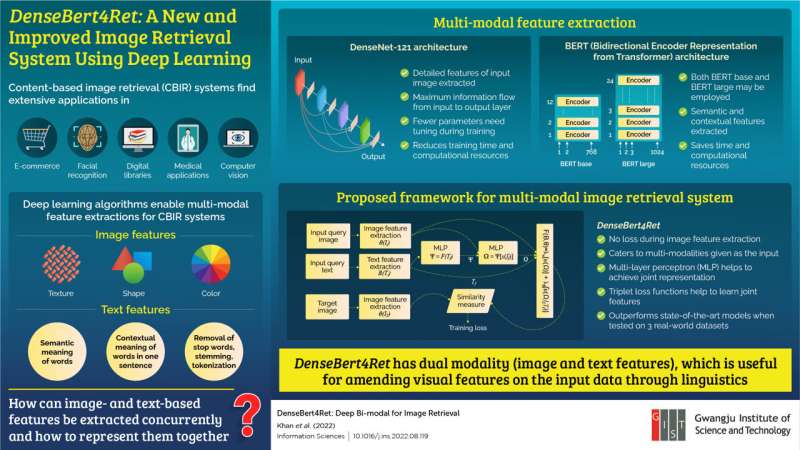Researchers from Gwangju Institute of Science and Technology in Korea, have developed a new image retrieval system called DenseBert4Ret, which uses deep learning for image and text feature extraction from a dual-mode input query, with potential applications in e-commerce, computer vision, and medicine. Credit: Moongu Jeon from Gwangju Institute of Science and Technology, Korea
With the amount of information on the internet increasing by the minute, and retrieving meaningful data from it is sometimes like trying to find a needle in a haystack. Content-based image retrieval (CBIR) systems are capable of retrieving desired images based on the user's input from an extensive database.
These systems are used in e-commerce, face recognition, medical applications, and computer vision. There are two ways in which CBIR systems work—text-based and image-based. One of the ways in which CBIR gets a boost is by using deep learning (DL) algorithms. DL algorithms enable the use of multi-modal feature extraction, meaning that both image and text features can be used to retrieve the desired image. Even though scientists have tried to develop multi-modal feature extraction, it remains an open problem.
To this end, researchers from Gwangju Institute of Science and Technology have developed DenseBert4Ret, an image retrieval system using DL algorithms. The study, led by Prof. Moongu Jeon and Ph.D. student Zafran Khan, was published in Information Sciences.
"In our day-to-day lives, we often scour the internet to look for things such as clothes, research papers, news article, etc. When these queries come into our mind, they can be in the form of both images and textual descriptions. Moreover, at times we may wish to amend our visual perceptions through textual descriptions. Thus, retrieval systems should also accept queries as both texts and images," says Prof. Jeon, explaining the team's motivation behind the study.
The proposed model had both image and text as the input query. For extracting the image features from the input, the team used a deep neural network model known as DenseNet-121. This architecture allowed for the maximum flow of information from the input to the output layer and needed tuning of very few parameters during training.
DenseNet-121 was combined with the bidirectional encoder representation from transformer (BERT) architecture for extracting semantic and contextual features from the text input. The combination of these two architectures reduced training time and computational requirements and formed the proposed model, DenseBert4Ret.
The team then used Fashion200k, MIT-states, and FashionIQ, three real-world datasets, to train and compare the proposed system's performance against the state-of-the-art systems. They found that DenseBert4Ret showed no loss during image feature extraction and outperformed the state-of-the-art models. The proposed model successfully catered for multi-modalities that were given as the input with the multi-layer perceptron and triple loss function helping to learn the joint features.
"Our model can be used anywhere where there is an online inventory and images need to be retrieved. Additionally, the user can make changes to the query image and retrieve the amended image from the inventory," concludes Prof. Jeon.
More information: Zafran Khan et al, DenseBert4Ret: Deep bi-modal for image retrieval, Information Sciences (2022). DOI: 10.1016/j.ins.2022.08.119
Provided by GIST (Gwangju Institute of Science and Technology)
























